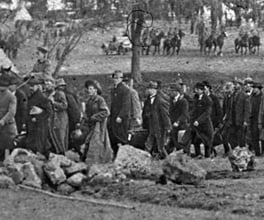Training & preparation
Although a system of compulsory military training existed in Australia before the war, the standing army comprised fewer than 3000 men. This number rose to 50,000 within three months and makeshift camps sprang up, taking over sporting fields and farms. In Victoria, the barracks at Broadmeadows served this role and men were trained to use bayonets, rifles and entrenching tools.
This sudden influx of men, along with a lack of military police, explains some of the Australians reputation for rowdy behaviour and larrikinism. From the very first days of their composition as the Australian Infantry Force, a looser standard of discipline existed in comparison to the British Army:
[E]very soldier was supposed to be in his blankets by 9:30pm. As a matter of fact, every night both men and officers thronged the streets and cafes in Melbourne.
- Glenn Wahlert
Wahlert, G 1999, The other enemy?, Oxford Press, Singapore
Square brackets should be used to show where you have made any alterations to the text like in the quotation above. Here the lower case 'e' in 'every' has been capitalised by the writer of this text.
With fears that England did not have the capacity to house and feed the new Australian troops, transport ships were re-routed to Egypt. In Cairo, many Australians took tours of the pyramids and tombs and haggled with Egyptian traders for souvenirs in markets. Again, the lack of military police and a system where rules were either inconsistently applied or applied too harshly meant activities away from the camp again became an issue:
They remained incorrigibly civilian, for they were not and did not wish to become regular soldiers. They were young men answering their country’s call; they would fight willingly, but they saw no point in the rigours and inanities of parade ground discipline, and until they reached the front they considered the army a job […] Out of working hours their time was their own…
- Bill Gammage
Gammage, B 2010, The broken years : Australian soldiers in the Great War, Melbourne University Publishing, Carlton, Vic.
Square brackets can also be used to show where you have made a deletion to the original text. Using an ellipsis inside square brackets (with spaces on either side) '[...]' shows that the writer of this piece has deleted a section of Gammage's original text. This is useful when working to a word limit or when you only require certain relevant points from a source. Remember to retain the intention of the original source.
A month before the Gallipoli landing, Australian troops were involved in the first incident of what would become known as the Wasser Riots. The troops rampaged through shops in a district of Cairo known for its bars and brothels, setting fire to some of the businesses and brawling with staff and owners.
Journalist C E W Bean reported that it was ‘obvious that there had also been enlisted a certain number of criminals, some of whom had entered the force with the intention of running gambling ‘schools’ or escaping punishment in Australia.’ He explained the army’s return of individuals in a column that was published in The Argus under the headline ‘Wasters in the Force’. In it, he described the perils of liquor and the risk of Australians earning a bad reputation.
Acting Prime Minister Billy Hughes dismissed claims of bad behaviour by Australian troops. Some members of the public expressed the view that such 'wasters' should be sent to the front line, a move they thought would either make Victoria Cross winners out of these men or at least bring them to their senses. In only a couple of months, Gallipoli would provide just such an opportunity.
The behaviour of Australian troops would continue to be a sticking point throughout the war. But looser discipline was considered by many of their superior officers as an acceptable ‘price’ when put beside their performance on the battlefield. Australians and New Zealanders were known as among the most fearsome and willing troops of the Allied forces.











